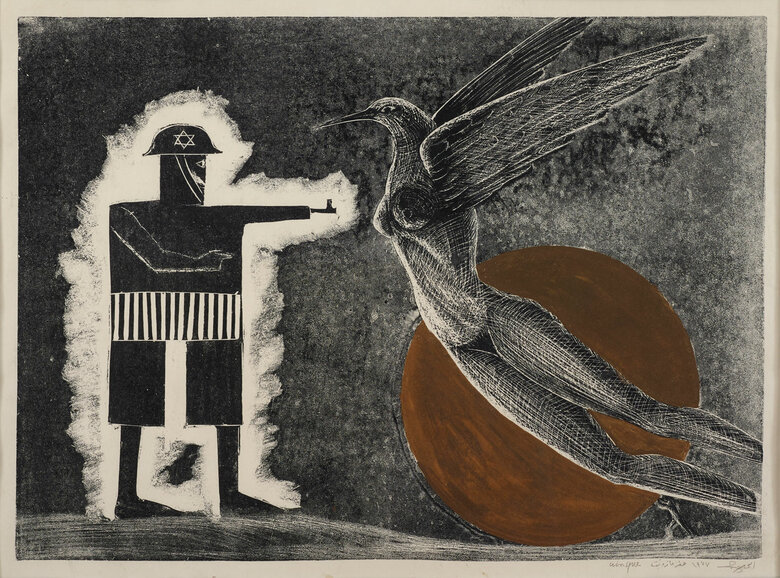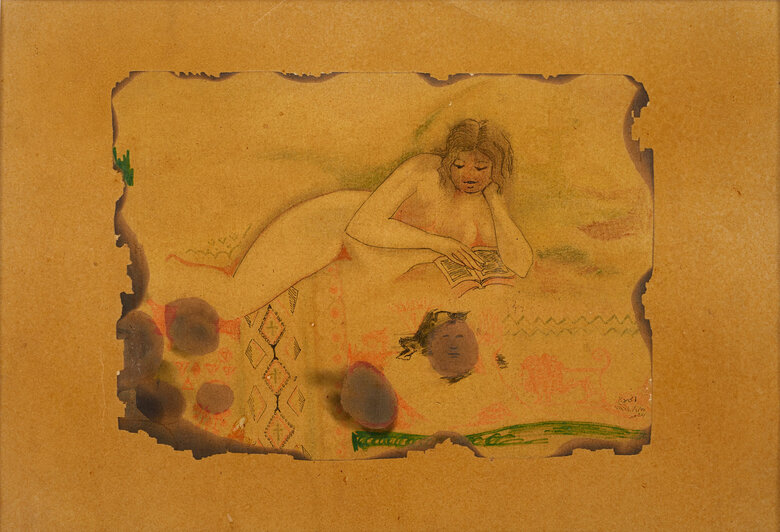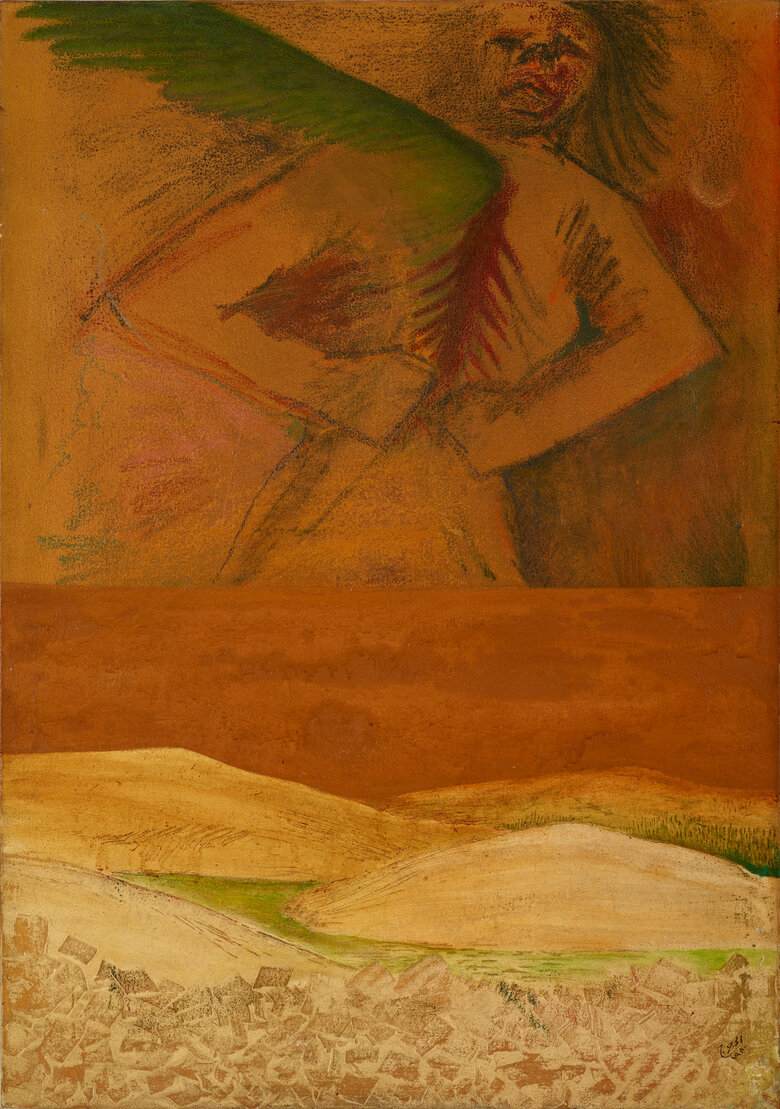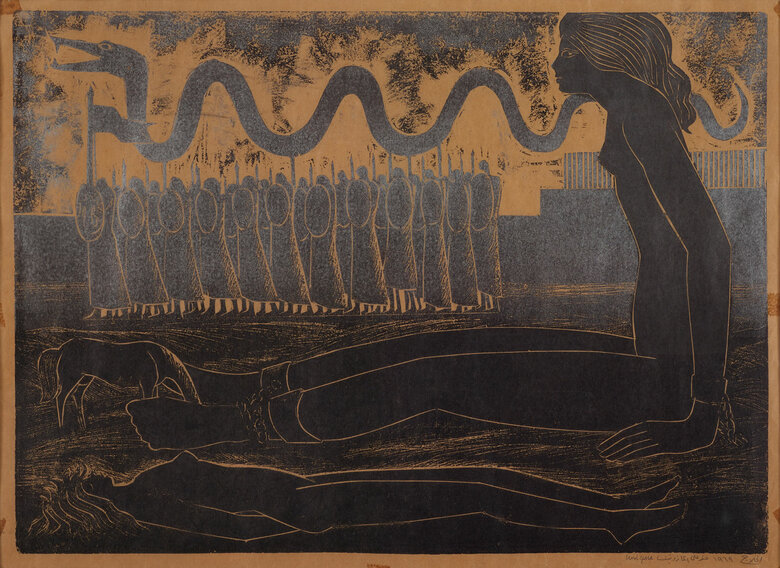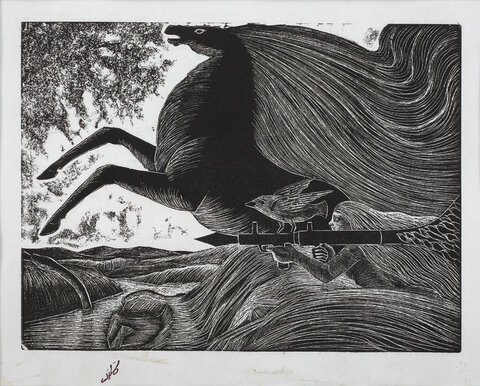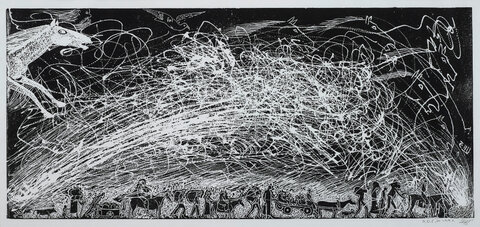Written by Alessandra Amin Mustafa El Hallaj was born in the village of Salama, near Jaffa, Palestine, in 1938. He came from a humble background; his father was a migrant farmworker, and some...

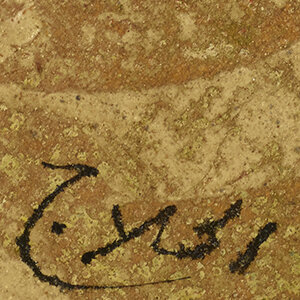
MUSTAFA EL HALLAJ, Palestine (1938 - 2002)
Bio
Written by Alessandra Amin
Mustafa El Hallaj was born in the village of Salama, near Jaffa, Palestine, in 1938. He came from a humble background; his father was a migrant farmworker, and some of his earliest memories were of traveling with him from orchard to orchard throughout the fertile agricultural regions of Palestine. When he was nine years old, El Hallaj and his family fled Zionist violence on foot, ultimately settling in Egypt, where the artist would complete all of his training. In 1963, he graduated in sculpture from the fine arts faculty of Cairo, and in 1968 he completed graduate training in Luxor. El Hallaj left Egypt in the early 1970s, living between Beirut and Damascus until 1983, when he permanently settled in the latter city.
Although El Hallaj spent most of his adult life outside of Egypt, his adopted homeland had a significant impact on his work. He considered himself “more Egyptian than many Egyptians,” and recognized the clay of the Nile, with which he played when a child, as his first artistic medium. His affinity for Egypt did not preclude his Palestinian pride, however, and he was an active participant in the cultural wings of the Palestinian Liberation Organization in Beirut and Damascus. Indeed, much of his best-known work engages with the struggle for Palestinian self-sovereignty. He believed that it was the duty of the Palestinian artist to combat, through art, the “self-denial” and “suffocation of historical heritage” that the Israeli occupation imposes upon Palestinians.
El Hallaj did not have an official position in the PLO, despite the degree to which his art resonated with the aims and ideals of the organization. In evidence, the fact that Yasser Arafat himself traveled to Damascus in 1974 for the launch of his exhibition.
While he trained as a sculptor, Mustafa El Hallaj largely abandoned the practice in the late 1960s in favor of a more suitable medium for his itinerant lifestyle. As he finished his studies in Luxor, he began to shift his focus to the portable forms of engraving and woodcut printmaking, for which he is celebrated today. Most notable about this oeuvre is its overt engagement with mythology; the artist evokes the visual cultures and spiritual beliefs of former Near Eastern civilizations, such as the Canaanites and the ancient Egyptians, interpolating these forms with militaristic or erotic imagery. His prints are animated by a sense of accumulation, of the layering of partial references to historical, mythological, and contemporary cultures within a realm of hallucinatory fantasy.
Where much scholarship presents El Hallaj as a direct and deliberate storyteller, the artist’s emphasis on his subconscious suggests that his work is deeply personal and almost auto-generative. His interest in dreams and other phenomena of the human psyche aligns his work closely with that of European Surrealists such as Andre Breton and Salvador Dali, but one cannot assume a direct influence. El Hallaj himself was a vocal opponent of art history’s Eurocentricity, claiming in a 1975 interview with Izzeddine al-Munasira that he rejected Western currents in Arab artistic production, though he embraced Western techniques. Although his provocative compositions echo Surrealism in their fluid blend of fantasy and eroticism, as well as their focus on the subconscious mind, El Hallaj drew inspiration from his belief that the creation and enjoyment of art was a hugely personal endeavor. Indeed, he was known to leave his work untitled because he believed interpretive work to be the duty of the viewer and did not wish to direct his audience in any particular way.
Personal though they may be, El Hallaj’s prints are undeniably in touch with social concerns. Even his most dreamlike compositions include direct references to armed struggle and invite dialogue with the more didactic strains of social realism, which were popular among contemporaneous Palestinian artists such as Ismail Shammout. The tension between the personal and the political that animates El Hallaj’s work renders its iconography tenuous and unstable, refusing to allow any image to stand as a fixed symbol.
El Hallaj was known as a gregarious entertainer, beloved for his generosity, his skills in the kitchen, and his distinctive Egyptian accent. He hosted regular literary salons at his home in Damascus during the mid-1970s, and his innovative work garnered the respect of artists from all over the political spectrum. Like many Palestinian artists of his era, however, his career was also marked by hardships and tragedy. In 1982, the Israeli assault on Beirut destroyed approximately 2500 of his works, which was a devastating blow to the artist. In 2002, an electrical fire burned his gallery and studio to the ground; he successfully rescued much of his work from the flames but died in a determined attempt to save more. He is buried in the Yarmouk Refugee Camp, Damascus.
Sources
Boullata, Kamal. Istihdar Al-Makan: Dirasa Fi Al-Fan Al-Tashkili Al-Filastini Al-Mu’asr. Tunis: Al-Munathara al-arabiyya lil tarbiya wa al-thiqafa wa ala’loum, 2000.
Boullata, Kamal, and John Berger. Palestinian Art 1850-2005. London; Berkeley, Calif.: Saqi, 2009.
Halaby, Samia. “Mustafa Al-El Hallaj: Master of the Print and Master of Ceremonies.” Jadaliyya, May 31, 2013. http://www.jadaliyya.com/pages/index/11918/mustafa-al-El Hallaj_master-of-the-print-and-master-o
Halaby, Samia. Liberation Art of Palestine: Palestinian painting and sculpture in the second half of the twentieth century. New York: H.T.T.B. Pub., S.A. Halaby, 2001.
Munasira, ʻIzz al-Dīn. Mawsūʻat al-fann al-tashkīlī al-Filasṭīnī fī al-qarn al-ʻishrīn: qirāʼāt tawthīqīyah tārīkhīyah naqdīyah. ʻAmmān: Majdalāwī lil-Nashr wa-al-Tawzī, 2003.
Melehi, Mohammad, Mustafa El Hallaj, and Nasser Soumi. “Masuwalitna ’adat Tathqif Al-Nas Jamilan.”Al-Hourriah no. 24 (1978): 41–42.
Sharaf, Rawan and Mirna Bamieh, eds. Diasporic Meanings: Mustafa El Hallaj Retrospective Exhibition. Jerusalem: Al-Hoash - Palestinian Art Court, 2013.
CV
Selected Solo Exhibitions
2013
Mustafa Hallaj: Diasporic Meanings. A Retrospect, Birzeit University Museum, Occupied Palestine
1964
Journalists’ Guild Sculpture Exhibition, Cairo, Egypt
Selected Group Exhibitions
*= possible solo exhibition; unverified
2017
Night was paper and we were ink, Barjeel Art Foundation Gallery, Maraya Art Centre, Sharjah, UAE
The Oslo Museum of Contemporary Art, Kunsthall Oslo, Oslo, Norway
2003
Made in Palestine, the Station Museum of Contemporary Art, Houston, USA
1999
Lattakia Biennale, Lattakia, Syria
1997
Festival International des Arts Plastiques de Mahres, Tunisia
1986
Alexandria Biennale, Alexandria
1972
Damascus,* Basra,* Carlton Hotel in Baghdad,* Iraqi Artists’ Group in Baghdad, Algiers, Rabat, Soviet Cultural Center in Cairo,* Al-Ghouri Agency in Cairo*
1970
Soviet Cultural Center, Cairo*, Egypt
1968
Alexandria Biennale, Alexandria, Egypt
Cairo Salon, Cairo, Egypt
Plastic Cultural Center, Cairo, Egypt
1967
Amsterdam*, The Netherlands
1961
Palestine Exhibition, Cairo
Awards and Honors
1999
First prize for etching, Laodicea [Lattakia] Biennale, Syria
1997
Gold prize for etching, Mahres Festival, Tunisia,
Prize for etching, Bangladesh
1995
International Honor Award, Sharjah Biennale, UAE
1986
First prize for sculpture, Alexandria biennale, Egypt
1968
Prize in sculpture, Cairo Salon, Egypt
Engraving prize, Alexandria biennale, Egypt
1961
Silver Medal at Palestine Exhibition, Cairo, Egypt
Collections
Mathaf: Arab Museum of Modern Art, Doha, Qatar
Barjeel Art Foundation, Sharjah, UAE
Ramzi and Saeda Dalloul Art Foundation (DAF), Beirut, Lebanon
The Birzeit University collection, Ramallah, Occupied Palestine
Collection of the artist Samia Halaby, New York, USA
Collection of George Al Ama, Bethlehem, Occupied Palestine
Press
«ارتجالات الحياة» في ذكرى وفاة الفنان الفلسطيني مصطفى الحلاج في دمشق,.pdf
دمشق تشيّع التشكيلي الفلسطيني مصطفى الحلاج.pdf
تنظيم معرض استرجاعي للفنان مصطفى الحلاج في مدينة القدس - وكالة وطن للأنباء.pdf
صحيفة الوسط البحرينية.pdf
مصطفى الحلاج.. ألف وجه للوحة الشهيد.pdf
مصطفى الحلاج فنان الأسطورة والصيرورة في ذكرى رحليه الثالثة.. روحه مسكونة بالمفردات اللامتناهية.pdf
الفنان مصطفى الحلاج.. اغتالته النيران وظلت لوحاته خالدة - صحيفة الرأي.pdf
Unknown face of Palestinian art - SFGate.pdf
Mustafa Al Hallaj _ Barjeel Art Foundation.pdf
Maydan-El Hallaj.pdf
مصطفى الحلاج.. حصان الميثولوجيا.. بقلم الفنان التشكيلي غازي أنعيم – سكلوز.pdf
تشكيليون فلسطينيون (18) الفنان مصطفى الحلاج - مؤسسة فلسطين للثقافة.pdf
حوش الفن يفتتح معرضا استرجاعيا للفنان الراحل مصطفى الحلاج.pdf
البعد الميثالوجي في أعمال الفنان الفلسطيني مصطفى الحلاج.pdf
الرمزية في أعمال الفنان مصطفى الحلاج الجماهير.pdf
Review_Palestinian Art and Possibility- Made in Palestine, an Examination..pdf
الفنان الفلسطيني مصطفى الحلاج.. تراجيديا في الحياة والموت.pdf
Profile_ The master of print & poster art, Mustafa Al Hallaj - EgyptToday.pdf
www.maaber.org-issue_may04-art1.pdf
مصطفى الحلاج.. التغريبة الفلسطينية كجوهر للإبداع.pdf
Profile_ The master of print & poster art, Mustafa Al Hallaj - Egypt Today.pdf
من أعلام فلسطين_ الفنان التشكيلي والنحات مصطفى الحلاج... - ميديا بلوس تونس.pdf
Jadaliyya.pdf
MUSTAFA EL HALLAJ Artwork
Become a Member
Join us in our endless discovery of modern and contemporary Arab art
Become a Member
Get updates from DAF
Follow Artists
Save your favourite Artworks
Share your perspectives on Artworks
Be part of our community
It's Free!
We value your privacy
TermsCookiesPrivacy Policies
Become a Member
Get updates from DAF
Follow Artists
Save your favourite Artworks
Share your perspectives on Artworks
Be part of our community
It's Free!
We value your privacy
TermsCookiesPrivacy Policies
Become a Member
Get updates from DAF
Follow Artists
Save your favourite Artworks
Share your perspectives on Artworks
Be part of our community
It's Free!
We value your privacy
TermsCookiesPrivacy Policies
Welcome to the Dalloul Art Foundation
Thank you for joining our community
If you have entered your email to become a member of the Dalloul Art Foundation, please click the button below to confirm your email and agree to our Terms, Cookie & Privacy policies.
We value your privacy, see how
Become a Member
Get updates from DAF
Follow Artists
Save your favourite Artworks
Share your perspectives on Artworks
Be part of our community
It's Free!
We value your privacy
TermsCookiesPrivacy Policies

